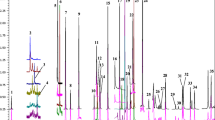Abstract
Thermally labile pesticides (captafol, captan, dicofol, and folpet) are highly prone to suffer thermal degradation during sample introduction into a gas chromatograph (GC) to tetrahydrophthalimide (THPI), 4,4′-dichlorobenzophenone (DCBP), and phthalimide (PI), respectively, mainly produced in the glass liner of the injector. This undesired behavior leads to inaccurate qualitative and quantitative results. Direct on-column injection (OCI) technique is evaluated as an alternative to avoid or minimize compound alteration during the analysis. This configuration was studied and evaluated for the determination of this group of thermally troublesome pesticides. The OCI inlet was operated in “track oven” temperature and connected to a wide-bore deactivated guard column that is itself connected to a capillary GC analytical column. This technique has demonstrated to be useful for avoiding degradation generated in the hot inlet. Limitations observed for OCI in routine analysis were injection volume, guard column length, and maintenance issues. Analytical standards spiked in vegetable solutions were injected in OCI, not observing any thermal degradation rate. On the contrary, classical splitless injection (SLI) produced high degradation rates in all cases. This OCI approach was validated in citrate QuEChERS extracts of tomato, apple, and orange matrices for these four compounds and their corresponding transformation products (THPI, DCBP, and PI), evaluating recoveries, repeatability, linearity, and matrix effect. This set-up enabled the correct identification and quantitation for most compounds at LOQs of 0.010 mg/kg in fruit and vegetable samples. The OCI grants evident differentiation between metabolites naturally occurring in food and thermal degradation products created during the analysis.

ᅟ







Similar content being viewed by others
References
EFSA. The 2014 European Union Report on Pesticide Residues in Food. EFSA J. 2016;14(10):139. https://doi.org/10.2903/j.efsa.2016.4611.
EFSA. The 2011 European Union Report on Pesticide Residues in Food. EFSA J. 2014;12(5):511. https://doi.org/10.2903/j.efsa.2014.3694.
Parrilla Vázquez P, Hakme E, Uclés S, Cutillas V, Martínez Galera M, Mughari AR, et al. Large multiresidue analysis of pesticides in edible vegetable oils by using efficient solid-phase extraction sorbents based on quick, easy, cheap, effective, rugged and safe methodology followed by gas chromatography–tandem mass spectrometry. J Chromatogr A. 2016;1463:20–31. https://doi.org/10.1016/j.chroma.2016.08.008.
Uclés S, Belmonte N, Mezcua M, Martínez AB, Martinez-Bueno MJ, Gamón M, et al. Validation of a multiclass multiresidue method and monitoring results for 210 pesticides in fruits and vegetables by gas chromatography-triple quadrupole mass spectrometry. J Environ Sci Health B. 2014;49(8):557–68. https://doi.org/10.1080/03601234.2014.911566.
Walorczyk S, Drodyński D, Gnusowski B. Multiresidue determination of 160 pesticides in wines employing mixed-mode dispersive-solid phase extraction and gas chromatography-tandem mass spectrometry. Talanta. 2011;85(4):1856–70. https://doi.org/10.1016/j.talanta.2011.07.029.
Zang X, Wang J, Wang O, Wang M, Ma J, Xi G, et al. Analysis of captan, folpet, and captafol in apples by dispersive liquid-liquid microextraction combined with gas chromatography. Anal Bioanal Chem. 2008;392(4):749–54. https://doi.org/10.1007/s00216-008-2296-1.
Lagunas-Allué L, Sanz-Asensio J, Martínez-Soria MT. Comparison of four extraction methods for the determination of fungicide residues in grapes through gas chromatography-mass spectrometry. J Chrom A. 2012;1270:62–71. https://doi.org/10.1016/j.chroma.2012.10.069.
Soares KL, Cerqueira MBR, Caldas SS, Primel EG. Evaluation of alternative environmentally friendly matrix solid phase dispersion solid supports for the simultaneous extraction of 15 pesticides of different chemical classes from drinking water treatment sludge. Chemosphere. 2017;182:547–54. https://doi.org/10.1016/j.chemosphere.2017.05.062.
Nesakumar N, Sethuraman S, Krishnan UM, Rayappan JBB. Cyclic voltammetric acetylcholinesterase biosensor for the detection of captan in apple samples with the aid of chemometrics. Anal Bioanal Chem. 2015;407(16):4863–8. https://doi.org/10.1007/s00216-015-8687-1.
Taccheo MB, Spessotto C, Bresin B, Bagarolo L. Multiresidue method for captan, folpet, captafol, vinclozolin and iprodione on italian apples and pears by capillary gas–liquid chromatography with electron-capture detection. J Pestic Sci. 1984;15(6):612–5. https://doi.org/10.1002/ps.2780150613.
González-Martín MI, Revilla I, Vivar-Quintana AM, Betances Salcedo EV. Pesticide residues in propolis from Spain and Chile. An approach using near infrared spectroscopy. Talanta. 2017;165:533–9. https://doi.org/10.1016/j.talanta.2016.12.061.
Rutkowska E, Łozowicka B, Kaczyński P. Modification of multiresidue QuEChERS protocol to minimize matrix effect and improve recoveries for determination of pesticide residues in dried herbs followed by GC-MS/MS. Food Anal Method. 2018;11(3):709–24. https://doi.org/10.1007/s12161-017-1047-3.
Lee J, Kim L, Shin Y, Lee J, Lee J, Kim E, et al. Rapid and simultaneous analysis of 360 pesticides in brown rice, spinach, orange, and potato using microbore GC-MS/MS. J Agric and Food Chem. 2017;65(16):3387–95. https://doi.org/10.1021/acs.jafc.7b00576.
Pesticide Properties Database [database on the Internet]. Available from: https://sitem.herts.ac.uk/aeru/iupac/index.htm. Accessed.
Group A. Fruit & vegetable business—further information, hints and recommendations by AGROLAB experts. Curent expert opinions and recommendations collected by our experts in fruit & vegetable residue analysis Read More: Folpet / Phthalimid residue definition causes severe irritation https://www.agrolab.com/en/agrolab-radar-2016-october/1341-information-hints-en.html.
Maštovská K, Lehotay SJ. Evaluation of common organic solvents for gas chromatographic analysis and stability of multiclass pesticide residues. J Chrom A. 2004;1040(2):259–72. https://doi.org/10.1016/j.chroma.2004.04.017.
EURL-SRM. Analytical observation report: quantification of residues of folpet and captan in QuEChERS Extracts. http://www.eurl-pesticides.eu/userfiles/file/EurlSRM/meth_CaptanFolpet_EurlSRM.pdf.
EFSA. Reasoned opinion on the review of the existing maximum residue levels (MRLs) for captan according to Article 12 of Regulation (EC) No 396/2005. EFSA J. 2014;12(4):55. https://doi.org/10.2903/j.efsa.2014.3663.
Council BCP. A world compendium. The Pesticide Manual 15th ed; 2009.
Boeker P, Leppert J. Flow field thermal gradient gas chromatography. Anal Chem. 2015;87(17):9033–41. https://doi.org/10.1021/acs.analchem.5b02227.
Zrostlíková J, Hajšlová J, Godula M, Maštovská K. Performance of programmed temperature vaporizer, pulsed splitless and on-column injection techniques in analysis of pesticide residues in plant matrices. J Chrom A. 2001;937(1–2):73–86. https://doi.org/10.1016/S0021-9673(01)01308-5.
Zlatkis A, Walker JQ. Direct sample introduction for large bore capillary columns in gas chromatography. J Chromatogr Sci. 1963;1(5):9–11. https://doi.org/10.1093/chromsci/1.5.9.
Grob K, Grob K Jr. On-column injection on to glass capillary columns. J Chrom A. 1978;151(3):311–20. https://doi.org/10.1016/S0021-9673(00)88346-6.
Alborn HT. A technique for thermal desorption analyses suitable for thermally-labile, volatile compounds. J Chem Ecol. 2018;44(2):103–10. https://doi.org/10.1007/s10886-018-0924-6.
Hakme E, Lozano A, Uclés S, Fernández-Alba AR. Further improvements in pesticide residue analysis in food by applying gas chromatography triple quadrupole mass spectrometry (GC-QqQ-MS/MS) technologies. Anal Bioanal Chem. 2017:1–16. https://doi.org/10.1007/s00216-017-0723-x.
SANTE/11813/2017 Guidance document on analytical quality control and method validation procedures for pesticide residues and analysis in food and feed, SANTE/11813/2017. 2018.
Grob K Jr, Neukom HP. Factors affecting the accuracy and precision of cold on-column injections in capillary gas chromatography. J Chrom A. 1980;189(2):109–17. https://doi.org/10.1016/S0021-9673(00)81511-3.
Grob K. On-column injection onto capillary columns. Part 2: study of sampling conditions; practical recommendations. J High Resolut Chromatogr. 1978;1(5):263–7. https://doi.org/10.1002/jhrc.1240010510.
Hossain MZ, Goto T. Determination of sterigmatocystin in grain using gas chromatography-mass spectrometry with an on-column injector. Mycotoxin Res. 2014;31(1):17–22. https://doi.org/10.1007/s12550-014-0214-2.
Hossain MZ, Goto T. A rapid determination of ergosterol in grains using gas chromatography–mass spectrometry method without derivatization. Food Anal Method. 2015;8(4):1021–6. https://doi.org/10.1007/s12161-014-9983-7.
Commission Regulation (EU) 2016/452 of 29 March 2016 amending Annexes II and III to Regulation (EC) No 396/2005 of the European Parliament and of the Council as regards maximum residue levels for captan, propiconazole and spiroxamine in or on certain products. 2016.
Commission Regulation (EU) 2016/156 of 18 January 2016 amending Annexes II and III to Regulation (EC) No 396/2005 of the European Parliament and of the Council as regards maximum residue levels for boscalid, clothianidin, thiamethoxam, folpet and tolclofos-methyl in or on certain products. 2016.
Acknowledgments
The authors acknowledge funding support from the European Commission, DG SANTE (Grant decision SI2.726352).
Author information
Authors and Affiliations
Corresponding author
Ethics declarations
Conflict of interest
The authors declare that they have no conflict of interest.
Rights and permissions
About this article
Cite this article
Uclés, S., Hakme, E., Ferrer, C. et al. Analysis of thermally labile pesticides by on-column injection gas chromatography in fruit and vegetables. Anal Bioanal Chem 410, 6861–6871 (2018). https://doi.org/10.1007/s00216-018-1286-1
Received:
Revised:
Accepted:
Published:
Issue Date:
DOI: https://doi.org/10.1007/s00216-018-1286-1




